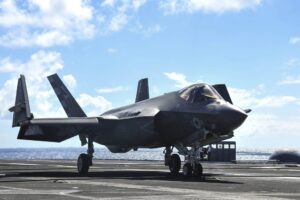All Services Sign On To Data Sharing – But Not To Multi-Domain
Posted on

Interservice comity on display at CSIS. Left to right: CSIS moderator Kathleen Hicks, Army Secretary Mark Esper, Navy Secretary Richard Spencer (who also oversees the Marines), Air Force Secretary Heather Wilson.
WASHINGTON: The four armed services are cooperating better than ever in a lots of ways, including a landmark agreement to buy compatible networks so they can actually share data in battle made public today. But the Navy still won’t officially sign on to the battle concept on which the Army and Air Force have staked their future: Multi-Domain Operations.
That contradiction was on full display this morning at a joint appearance by the three service secretaries: Heather Wilson for the Air Force, Mark Esper for the Army, and Richard Spencer for the Navy and Marines. I can’t remember any of their predecessors ever doing this together, but this trio has done this twice in 12 months (both this time and last time at the Center for Strategic & International Studies).
Even more stunning, they’ve been having breakfast together every two weeks that entire time – and without their staffs present. Those morning meetings, Wilson added, force all their subordinates to get together and hammer out any differences between the services before the three secretaries decide to settle it with a handshake over pancakes. “I think what they say is, ‘we’d better sort this out because if we give to them, we have no idea what they’re going to do,’” she said to laughter.
“The three of us are completely aligned on our overall goals, wearing our Title 10 hats, and now we’re aligning resources,” Spencer said more solemnly.
One example, Wilson added immediately, is the joint memo on communications standards they recently signed: “It’s probably one of the most important things we’ve done together.”
The services have historically struggled to communicate in combat. There’s an infamous albeit often exaggerated anecdote that, during the invasion of Granada in 1983, an Army officer had to call for Navy fire support on a civilian phone line because he couldn’t find a compatible radio. In the modern era, with its flood of data from satellites, surveillance drones, and GPS-tracked vehicles, it’s even more crucial and even more complicated to get everyone’s wireless communications networks to work together.
Hence the memo, in which the three secretaries direct their acquisition chiefs to make future weapons systems use compatible data-sharing standards, part of what’s called the Modular Open Systems Approach (MOSA), although I understand there’s no specific timeline prescribed to make this actually happen.
The vision is a future force that can share data swiftly and seamlessly – where the enemy is, where friends are, what to shoot ASAP and what not to kill — from submarine to foot soldier to fighter jet to satellite. As soon as anyone spots a target, everyone can see it and whoever’s best positioned can take it out — “any sensor, any shooter,” as Wilson and Spencer both summed it up today.
“Take the F-35 as an example,” Spencer said: “One of the goals obviously is a platform in the air that can call on any platform to deliver any weapon.” The services argue that the F-35 is uniquely suited, not just to sneak stealthily into enemy airspace, but to spot targets with its sophisticated sensors and then transmit the targeting data to less stealthy but more heavily armed aircraft – or even ships and artillery batteries – to take the actual shot.
That concept requires much more than people talking on compatible radios: It takes computers — probably, in fact, artificial intelligences — updating one another, across vast distances, in the time it takes a human being to blink. “We need to be able to have any sensor connect to any shooter at very rapid machine-to-machine speed,” Wilson said, “if we’re going to multi-domain operations.”
But aye, there’s the rub. Yes, the Air Force and Army have both publicly committed to Multi-Domain Operations: in essence, taking apart advanced enemies like Russia or China with relentless, coordinated attacks from all five domains of war – land, sea, air, space, and cyberspace. Their generals talk about it all the time, right up to their respective four-staff chiefs of staff, David Goldfein and Mark Milley (who’s been tapped to become Chairman of the Joint Chiefs of Staff). Both Wilson and Esper invoked the term today. Esper in particular emphasized how the Army, using new long-range precision missiles, could support both the Air Force and Navy. It could bombard enemy anti-aircraft batteries too dangerous for airplanes to approach, for example, or even spot and sink ships from shore, as an Army missile battery did in a recent exercise, he noted proudly.
But the Navy has not officially endorsed Multi-Domain Operations, which means it can’t become an official joint concept shared by all the services, which means it won’t be enshrined and enforced in joint acquisition, budgeting, and doctrine. In fact, despite having some very similar ideas themselves, Navy leaders consistently avoid even using the term “multi-domain”– as Spencer did today, until I asked him about it in Q&A.
“You talk about multi-domain,” the Navy Secretary replied. “Look at the air wing of an aircraft carrier: It can shoot a ship, it can shoot a plane, it can deliver power to project on land. Look at the P-8 [a land-based Navy airplane]: It can launch a Harpoon [anti-ship missile], it can launch a torpedo, or it can also be your information gathering, your surveillance.
“We are in multi-domain every single day,” Spencer said. “If we didn’t sign up and say it’s something new, I apologize,” he added, to laughter from the audience.
That response didn’t actually address whether the Navy had formally signed up to the Multi-Domain concept as have the Army and Air Force. So I slipped up to Spencer after the CSIS panel and asked again: Yes, the Navy operates in multiple domains – sea, air, even space – but there’s no public sign it’s working on this concept with the other two services….
“We live in the multi-domain,” Spencer said. “That’s why it’s nothing new for us.”
But are you working with the Army and the Air Force?
“Oh yes,” he said. “[Any] sensor, [any] shooter goes across all services. Link-16, that’s the backbone, and you look at how we’re developing F-35, that’s going to pick up any weapon, any platform, anywhere — [that’s] the ultimate goal, and if that’s not multi-domain, I don’t know what is.”
Link-16, for reference, is a NATO communications protocol in widespread use since the 1990s; it’;s necessary but hardly sufficient for multi-domain command and control. The F-35 is much newer and more sophisticated, but it’s still one weapon, not a whole intellectual framework for future war. So I tried again: Is the Navy signing on to this specific, formal concept?
“We have; we’re living it,” Spencer said. “I don’t know how much more we can sign onto.”
At that point his staff shepherded the Navy Secretary off to his next appointment.
Subscribe to our newsletter
Promotions, new products and sales. Directly to your inbox.




